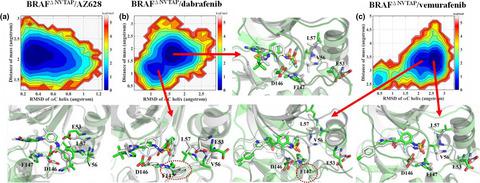当前位置:
X-MOL 学术
›
Chem. Bio. Drug Des.
›
论文详情
Our official English website, www.x-mol.net, welcomes your feedback! (Note: you will need to create a separate account there.)
Resistance mechanism of the oncogenic β3‐αC deletion mutation in BRAF kinase to dabrafenib and vemurafenib revealed by molecular dynamics simulations and binding free energy calculations
Chemical Biology & Drug Design ( IF 3 ) Pub Date : 2018-10-08 , DOI: 10.1111/cbdd.13399 Yuzhen Niu 1 , Yan Zhang 2 , Xiaojun Yao 3
Chemical Biology & Drug Design ( IF 3 ) Pub Date : 2018-10-08 , DOI: 10.1111/cbdd.13399 Yuzhen Niu 1 , Yan Zhang 2 , Xiaojun Yao 3
Affiliation

|
BRAF kinase is an essential target for anti‐cancer drug development. Emergence of the β3‐αC loop deletion mutation (ΔNVTAP) in BRAF kinase frequently occurred in human cancers seriously compromises the therapeutic efficacy of some BRAF kinase inhibitors, such as dabrafenib and vemurafenib. However, the mechanism of this resistance is still not well understood. In this study, the influence of the β3‐αC deletion mutation on the binding profiles of three BRAF kinase inhibitors (AZ628, dabrafenib, and vemurafenib) with BRAFV600E or BRAFΔNVTAP was explored by conventional molecular dynamics (MD) simulations and binding free energy calculations. The simulation results indicated that the β3‐αC deletion mutation enhances the flexibility of the αC helix and alters their conformations, which amplify the conformational entropy change (−TΔS) and weaken the interactions between the inhibitors and BRAF. The further per‐residue binding free energy decomposition analysis revealed that the ΔNVTAP mutation changed the contributions of a few key residues to the bindings of dabrafenib or vemurafenib, such as L57, L66, W83, C84, F135, G145, and F147, but did not have obvious impact on the contributions of these residues to AZ628. Our results provide valuable clues to understand the mechanisms of drug resistance conferred by the β3‐αC deletion mutation.
中文翻译:

通过分子动力学模拟和结合自由能计算揭示了BRAF激酶致癌性β3-αC缺失突变对达布拉非尼和维罗非尼的耐药机制
BRAF激酶是抗癌药物开发的重要靶标。在人类癌症中经常发生的BRAF激酶中的β3-αC环缺失突变(ΔNVTAP)的出现严重损害了某些BRAF激酶抑制剂(如dabrafenib和vemurafenib)的治疗效果。但是,这种抗性的机理仍未得到很好的理解。在这项研究中,β3-αC缺失突变对三种BRAF激酶抑制剂(AZ628,dabrafenib和vemurafenib)与BRAF V600E或BRAFΔNVTAP的结合谱的影响通过常规分子动力学(MD)模拟和结合自由能计算来探索。仿真结果表明,β3-αC缺失突变增强了αC螺旋并改变其构象,其放大所述构象熵变化(的灵活性- Ť Δ小号)并削弱抑制剂与BRAF之间的相互作用。进一步的每个残基的结合自由能分解分析显示,ΔNVTAP突变改变了一些关键残基对达布拉非尼或维拉非尼结合的贡献,例如L57,L66,W83,C84,F135,G145和F147,但确实如此对这些残留物对AZ628的贡献没有明显影响。我们的结果为理解β3-αC缺失突变赋予的耐药机制提供了有价值的线索。
更新日期:2018-10-08
中文翻译:

通过分子动力学模拟和结合自由能计算揭示了BRAF激酶致癌性β3-αC缺失突变对达布拉非尼和维罗非尼的耐药机制
BRAF激酶是抗癌药物开发的重要靶标。在人类癌症中经常发生的BRAF激酶中的β3-αC环缺失突变(ΔNVTAP)的出现严重损害了某些BRAF激酶抑制剂(如dabrafenib和vemurafenib)的治疗效果。但是,这种抗性的机理仍未得到很好的理解。在这项研究中,β3-αC缺失突变对三种BRAF激酶抑制剂(AZ628,dabrafenib和vemurafenib)与BRAF V600E或BRAFΔNVTAP的结合谱的影响通过常规分子动力学(MD)模拟和结合自由能计算来探索。仿真结果表明,β3-αC缺失突变增强了αC螺旋并改变其构象,其放大所述构象熵变化(的灵活性- Ť Δ小号)并削弱抑制剂与BRAF之间的相互作用。进一步的每个残基的结合自由能分解分析显示,ΔNVTAP突变改变了一些关键残基对达布拉非尼或维拉非尼结合的贡献,例如L57,L66,W83,C84,F135,G145和F147,但确实如此对这些残留物对AZ628的贡献没有明显影响。我们的结果为理解β3-αC缺失突变赋予的耐药机制提供了有价值的线索。


























 京公网安备 11010802027423号
京公网安备 11010802027423号